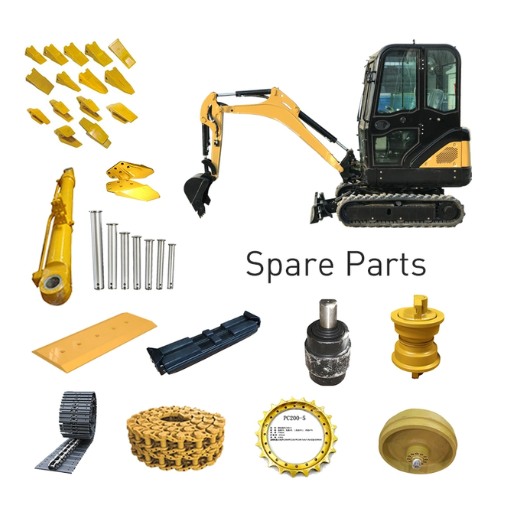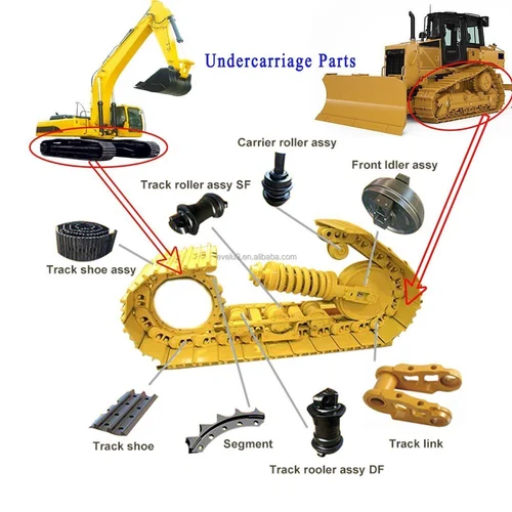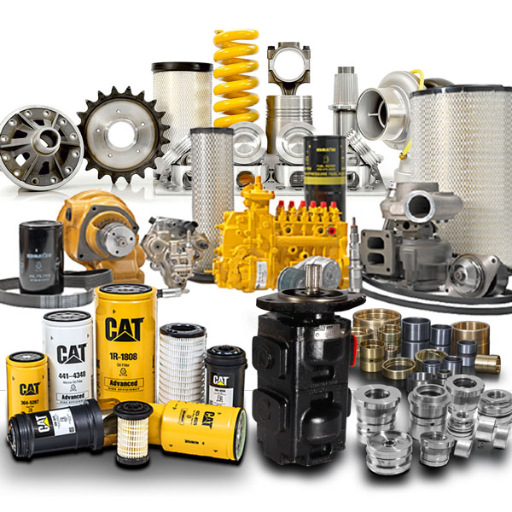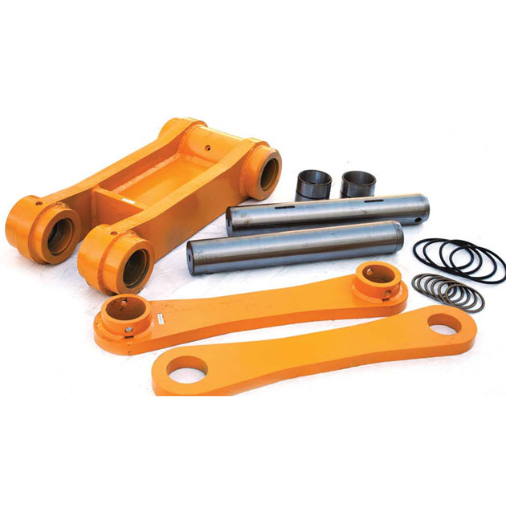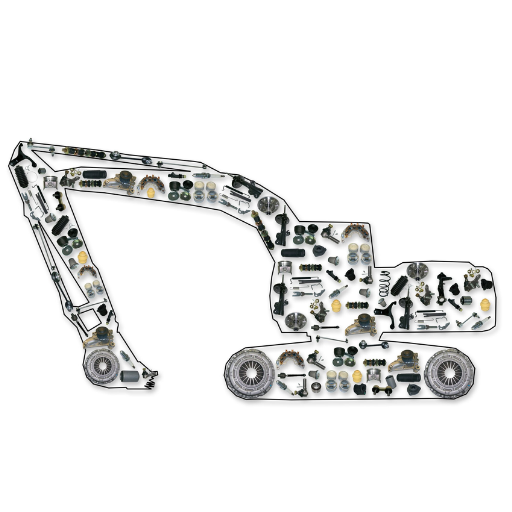When it comes to the construction industry, excavators are undoubtedly one of the most powerful and versatile pieces of equipment. Not only do they dig and trench, they can also demolish and do some sand and concrete moving work. Of course, there is a premise here: these machines require regular maintenance and timely repairs to remain as effective and efficient as they should be. This blog is designed to help you understand the key parts in your excavator that may need to be replaced so that you can keep it in working order. If you take into account the purpose of the different parts, once any part wears out, you will know it is time to replace that part, thereby reducing the level of risk and delay.
What are the key components of an excavator?
Powertrain
The powertrain is often defined as the internal combustion engine. It can also be considered the heart of the machine as it produces the energy needed to drive the machine. Proper maintenance of the engine is essential as it affects the operation of the excavator, and engine maintenance can reduce repair costs.
Hydraulic system
The hydraulic system is the main working system of the excavator. It efficiently moves the boom, arm and bucket and coordinates their actions. The system contains many components such as pumps, motors, cylinders and hoses, which need to be properly maintained; otherwise, it may cause reduced efficiency or leakage problems.
Tracks or tires
Tracks or tires help ensure the movement and balance of the excavator. Worn tracks and tires need to be checked and replaced regularly to ensure the safety of the machine on the construction site and improve its maneuverability.
Boom, Arm and Bucket
These components are directly involved in the excavation operation of the excavator. Regular inspection is necessary, and worn bushings and pins need to be replaced to improve work efficiency and ensure higher precision.
Chassis
The undercarriage consists of track rollers, idlers and sprockets, which are important parts for the efficient movement and operation of the machine. Regular inspection and maintenance of these components can improve the performance and life of the excavator.
Understand the basic parts of an excavator
To appreciate excavators, it is essential to understand the key features of most models. These key elements have been defined in the current Google top sites as follows:
- Engine: The engine is the main functional component of the excavator, providing power to the hydraulic system. It is essential for the excavator's mobility and for performing operations such as drilling.
- Hydraulic System: This system consists of a combination of pumps, motors, valves and cylinders that help the machine's arms, booms and attachments to operate hydraulically. Its purpose is to increase the overall productivity of the excavator in various operations.
- Tracks or Tires: Tracks or tires provide stability and mobility and need to be constantly monitored for wear. These components are necessary for safe and good performance of the machine on all terrains.
All three components perform functions required of an excavator and are therefore referred to as functions. Regular maintenance of each part is necessary to support optimal operation of the machine.
Key components: arm, boom and bucket
In an excavator, the arm, boom, and bucket are important components, each with a specific function. The boom is the structure attached to the cab and is used to lift and extend for digging and lifting activities. The arm is responsible for pushing and pulling, adjusting the distance and position of the excavator bucket. The bucket itself is used to perform digging tasks and may vary in shape and size depending on the job being performed, such as shoveling or trenching. The performance of an excavator can be measured by its soil and debris control elements, which allow it to perform various digging activities with ease. Maintenance practices for these components ensure that the excavator operates efficiently in different working environments and applications.
Hydraulic Systems: Importance and Operation
The hydraulic system is a key feature of an excavator and is responsible for performing any movement or energy use of the machine. The system is able to convert hydraulic pressure into mechanical work to achieve high-precision and powered movement of multiple parts of the excavator, including the arm, boom and bucket. The effectiveness of this system helps provide finer and more responsive control, which is important for tasks that require precise operation, such as trenching and lifting heavy objects. Regular inspections of the hydraulic system, such as checking for possible leaks and fluid levels, ensuring that the fluid level is frequently above the basic level, can prevent time loss and extend the life of the machine. This also promotes overall efficiency and ensures safety on site.
How to choose high-quality excavator parts?
Finding quality parts for your excavator requires an investment of money and consideration of multiple aspects, such as compatibility, durability, and brand. The first step is to make sure the parts are compatible with your specific excavator model to avoid performance issues. Secondly, choose parts that are made of strong materials that can withstand heavy-duty applications. It is also wise to purchase parts from reputable manufacturers that have a proven track record of reliable construction equipment. Also, consider warranties and customer reviews to assess the performance and reliability of the parts. After noting these features, it can be safely said that your excavator parts will enhance the performance and life of your machine.
OEM & Aftermarket Excavator Parts
When deciding which type of part to use (genuine part or off-the-shelf replacement), there are a number of pros and cons that need to be carefully considered.
OEM parts are original parts made by the same company as the manufacturer of the equipment. These replicas of original equipment components are manufactured to the same tolerances and engineering standards as the original parts, ensuring proper fit and function. They often come with worry-free warranties and other services, alleviating a lot of worry. However, OEM parts tend to be priced higher, relative to aftermarket parts.
A large number of aftermarket parts are manufactured by third-party companies, which makes the price and quality of the parts vary greatly. These parts are usually less expensive and sometimes contain features that OEM parts do not have. However, differences in standards can cause compatibility and performance issues. Therefore, it is crucial to purchase aftermarket parts from reputable manufacturers and ensure that these parts meet the technical parameters and performance standards required of your excavator.
Technical parameters to consider:
- Material Composition: OEM and aftermarket parts should use high-quality materials suitable for heavy-duty applications.
- Load-carrying capacity: Ensuring that the parts can withstand the loads and pressures unique to your particular excavator model is critical.
- Dimensional Accuracy: The measurements of the required parts must be precise to avoid any malfunctions.
- Wear resistance: Evaluates the ability of a component to resist wear due to environmental conditions and usage patterns.
- Warranty: Learn about warranty periods and conditions to ensure the safety and quality of your investment.
These interrelated aspects must be carefully considered and the technical parameters observed in order to make decisions that will maximize the performance, cost and life of your excavator.
Identify genuine parts for your excavator
To identify high-quality parts for your excavator, it is worth considering the specifications provided by the original equipment manufacturer (OEM) and aftermarket options.
- Material Composition: Quality parts should use materials that can withstand the harsh conditions and operations associated with heavy equipment. This ensures durability and reduces the possibility of part failure.
- Load-carrying capacity: An important aspect is whether a part is tested and approved to handle the varying weights and pressures of the excavator model it is used in. This standard is critical to preventing unnecessary equipment degradation or catastrophic failure.
- Dimensional Accuracy: Quality parts should be manufactured to precise dimensions. Dimensional inaccuracies can lead to assembly problems, which in turn can cause inefficient machine operation.
- Wear resistance: Choose parts that are highly resistant to the extensive use or extreme working conditions of the excavator. The greater the wear resistance, the longer the service life of the part, making it more cost-effective.
- Warranty: A device that comes with a reasonable warranty is usually a good purchase because it shows that the OEM is confident in the quality of its product. The warranty protects the investment and provides peace of mind about the adequacy of parts.
- Manufacturing Reputation: Understand the background and reputation of the manufacturer. Reputable manufacturers have usually been in business longer, tend to provide higher quality components, and are better able to serve customers and produce satisfactory products.
Taking these parameters into consideration will help you choose the right parts to increase the effectiveness and durability of your excavator while maximizing its performance, no matter what conditions it is placed in.
Volvo and Caterpillar excavator parts analysis
When comparing Volvo, special attention should be paid to the current industry trends and areas of equipment development that can be judged. Caterpillar parts are known for being durable, using the most advanced technology, and often leading the market. They have a large selection of aftermarket products and ensure that these products are tested for fit and performance. However, the material quality of Volvo parts is quite high, and they provide additional warranties in various aspects, which will help you use them for a long time without worrying about performance. As an industry that advocates sustainable development, Volvo incorporates environmental practices into its parts development process. Both manufacturers have long established a strong global parts sales center, which means that the end customer will always have access to necessary consumables after purchase and throughout the life cycle. Ultimately, the difference in the use of Volvo and Caterpillar parts lies in operating characteristics, personal preferences, and financial capabilities.
What is the role of the chassis in an excavator?
The undercarriage of an excavator is the most important part of the machine. It carries the weight of the machine and provides stability during work. The undercarriage consists of important components such as tracks, rollers, idlers, and gears, each of which is essential for movement and support. The undercarriage enables the excavator to move over various terrains as it evenly distributes the weight of the excavator. Given that all these components play an important role in maintenance, regular maintenance is necessary to ensure maximum efficiency and functionality of the machine for the longest time, and also to avoid overuse of these components that can lead to costly repairs. The undercarriage frame is also crucial to the working functions of the excavator, such as lifting, digging, or other heavy mechanical operations.
Components of the chassis: rollers and gears
Gears and rollers are vital user group components in any excavator undercarriage, and they each perform different and important roles. The rollers’ job is to carry the weight of the machine, preventing the tracks from deviating from the plane of the wheels, ensuring that the weight is evenly distributed over the terrain. This distribution helps to reduce friction, resulting in smoother movement and greater efficiency. However, the tracks have gears on them that are used to combine with the rail links to drive the tracks to move, thus converting the engine’s power into movement. Both of these components are extremely important and must be kept in good working order, as wear or inaccuracy can increase the risk of damage and reduce efficiency. Due to their high levels of wear, it is vital to regularly inspect these parts and replace them when they are too old, so as not to affect the overall stability and functionality of the undercarriage.
Keep your excavator undercarriage in good condition
To maintain the undercarriage of your excavator, it is imperative to perform a systematic assessment and provide regular maintenance. The maintenance process should begin with regular cleaning of the undercarriage to remove dirt and other material that could cause damage. Ensure that the tracks are properly tensioned and adjust them when necessary to avoid slipping or overstretching. Carefully inspect the rollers, idlers, and gears to determine the extent of wear and replace any severely worn parts. It is inevitable that certain parts in a mobile machine will rub against each other, and in order to reduce this friction and extend the life of these parts, lubrication should be performed as required. When these maintenance measures are performed in a timely manner, the performance of the undercarriage will be improved, costly repairs will be avoided, and the efficiency of the excavator will be at its best.
How to rebuild excavator components?
Each step ensures that the various excavator components are restored to acceptable operating levels after the repair. First, the defective parts are carefully disassembled, ensuring that no components or their sequence are missed. All parts are assessed for wear and tear to determine which ones need to be replaced. All components and isolated internal surfaces must be thoroughly cleaned. During the cleaning process, any worn parts should be replaced with original manufacturer-approved parts to ensure perfection. Components should be accurately put back in place and all moving parts lubricated as per the manufacturer's instructions. Before the rebuilt parts are put into the excavator, reliable inspections are carried out to ensure their proper functioning. Therefore, there are no technical aspects that make it easier to follow, ensuring that they work effectively when they are performed.
A Step-by-Step Guide to Rebuilding a Hydraulic Cylinder
- Preparation and Disassembly: Preparation includes allocating time and space for each stage, ensuring that the cylinder is placed in a clean area, releasing the pressure in the cylinder or performing other necessary procedures, and removing it from the equipment. Starting with the earrings, gradually remove all components in the cylinder and place them in order for easy reconstruction.
- Inspection: With the locking device closed, slide the cylinder barrel forward, focusing on the seals and carefully inspecting for visible scratches. Thoroughly evaluate the cylinder bore, piston rod, seals, and other cylindrical components for cracks. In particular, note that most scratches are on the surface of the piston rod, which is subject to unnecessary friction.
- Cleaning: All parts should be soaked or cleaned with solvent to remove any dirt, grease or debris. Make sure every particle is cleaned away as any contaminant may accelerate wear on new seals or other replacement parts.
- Replace seals and worn parts: Identify defective and/or missing seals, O-rings or other components and replace them with new ones. Use OEM replacement kits, otherwise it is difficult to ensure each part is installed correctly and maintains performance specifications.
- Reassembly: After cleaning and inspecting the cylinder components, reassemble in the reverse order of disassembly. Lubricate areas requiring movement and lubricant. Make sure all components are securely mounted and properly aligned.
- Testing: After assembly, the hydraulic cylinder is tested for leakage and smoothness of operation under appropriate conditions. After the final operational test, the cylinder is installed back into the equipment to check that it works properly in the system.
Following these steps will help you repair your hydraulic cylinder and ensure it runs smoothly for months to come.
Rebuilding of excavator arms and booms
A coordinated approach is key to rebuilding an excavator arm and boom. Start by disassembling the excavator arm and boom, making sure all hydraulic lines and connections are clearly marked for easy repair later. Inspect components for cracks, bends, or other signs of wear that could affect their structural integrity. Any worn or damaged components must be replaced with high-quality materials that meet OEM standards to ensure durability and quality. Proper hand position and posture should be ensured during reassembly to ensure proper relationship. This includes installing the removed components back into the excavator, replacing hydraulic lines, and performing functional testing to ensure proper operation. With continued maintenance, the life of your excavator arm and boom will be extended, productivity will be increased, and downtime will be reduced.
Affordable Ways to Rebuild
When considering affordable ways to rebuild heavy machinery, such as heavy hydraulic cylinders, arms, and excavator booms, it’s important to focus on materials and workmanship.
- Material selection: Most suppliers offer high-standard aftermarket components that are comparable or better than OEM products. In some cases, heat-treated steels and reinforced alloys may be less expensive than original equipment replacement parts while offering the same strength.
- Technical parameters: Ensure that the material's hardness, tensile strength and corrosion resistance have been tested and confirmed. In particular, steel with a tensile strength of at least 1200 MPa should be selected to withstand any operating pressure.
- Labour and Tools: If possible, consider rebuilding in-house, i.e. if skilled labour and necessary tools are available, which will reduce labour costs drastically. Some multi-purpose fixtures or multi-purpose tools need to be introduced to reduce future overhead costs as specialist equipment and tools will not be required.
- Routine maintenance: Through effective maintenance practices, you can reduce the rate of wear and tear and replace parts in advance before they reach dangerous levels that would lead to complete failure. Avoid the hassles that come with long-term equipment failures; use predictive maintenance tools to ensure that small problems do not become big problems.
- Supplier Relationships: You need to find good suppliers and build good relationships with them. You can save costs by seeking out offers such as bulk auction discounts or loyalty programs, especially for related parts and materials.
In this way, low-cost reconstruction sequences can be performed without loss of performance, thereby increasing the operational capabilities of equipment and certain machinery.
What are the FAQs about excavator parts?
Available Construction Equipment Parts Q&A
Which parts of the excavator are most critical to maintain?
Customers must also pay attention to the hydraulic system, which drives the digging arm and controls different attachments or tools. Maintenance of hydraulic fluid and seals or hoses is very important. Undercarriage parts, such as tracks, sprockets and idlers, also require regular inspection and attention to reduce wear.
How long is too long to maintain excavator parts?
The time required to replace a part depends on the specific component. Hydraulic hoses are generally replaced between 1000 and 2000 hours of further operation, while chassis components may have a service life of between 1200 and 2500 hours, depending on usage conditions and maintenance. Following the manufacturer's maintenance instructions will help to better understand usage.
Which technical parameters should I follow when ordering new spare parts?
Make sure to follow important measurements such as tensile strength, material hardness, and internal fittings arrangement. Hydraulic hoses should not be rated less than 4000-6000 PSI as this is the working range of the excavator. The use of bulk materials is also highly dependent on wear parts such as bucket teeth, which should be hardened with high manganese steel or equivalent for heavy-duty use. It is important to emphasize that all parts used for maintenance should follow OEM guidelines.
By answering the common questions above, operators can make informed decisions on maintenance and replacement of excavation components and bars, effectively increasing the productivity and life of their equipment.
Which parts are better suited for excavators than others?
When determining the right spare parts for your Zebra excavator, factors such as spare parts compatibility, technical specifications and quality must be considered. Here are some simple steps to help you:
- Read the manual and OEM maintenance recommendations: The first step is to obtain your excavator owner's manual and OEM maintenance recommendations. These documents contain technical specifications and an index of part numbers required for compatibility with the machine.
- Browse Internet Inventory: Online resources such as Parts.Cat.com, MachineryTrader.com and MyKomatsu.com further provide the ability to search by part number, machine model or specific system component, allowing users to find the target part through a vast online inventory. Use these resources to help check whether the part you are about to order will fit a specified brand and type of excavator.
- Consider reputation and standards: Order parts only from the right suppliers or manufacturers that follow the standards of the original equipment manufacturer (OEM). Adhering to these standards means following the durability and performance specifications of the parts, such as the tensile strength of hydraulic components, the hardness of wear parts, and the operating environment of the parts.
- Pay attention to specifications: For example, when selecting a hydraulic hose, make sure the hose's operating pressure rating is within the range of your equipment, which is usually between 4,000 and 6,000 psi. Undercarriage components or bucket teeth should also be made of high-manganese steel or other similar materials to ensure strength and durability.
By utilizing these programs and searching online, one can easily find the parts they need that will aid in the operation of their excavator and ensure the long-term use of their equipment.
What are the signs of wear on excavator parts?
Based on my observations and research, some signs of worn excavator parts include a decrease in performance and efficiency, such as a reduction in working speed or digging ability. I usually find more vibrations or even unusual sounds when working, which means that some parts are wearing out or damaged. Visual inspections can reveal problems with key components such as bucket teeth and hydraulic hoses, such as cracks, deformations, or breaks. Observing hydraulic leaks at seals or low levels of hydraulic fluid may indicate problems with hoses or seals. Paying attention to these signs helps me keep my excavator running efficiently and prevent unnecessary engine failures.
How to find suppliers of excavator replacement parts?
From my current web search, it is clear that there are several reputable companies that sell excavator parts. eBay and Amazon are well-known sites that stock many new and used parts, and in most cases are accompanied by customer reviews of the quality of these items. However, for customers who just want genuine parts, aftermarket parts can also be found on PartsCat, where parts from manufacturers are available. Another such source is RockAuto, which offers a large number of parts from many different brands, some of which are relatively cheap, so I didn't have to pay more than the cost of the part.
FAQ
Q: What are the most common parts in excavator maintenance?
A: Common parts included in excavator maintenance include hydraulic pumps, track pads, final drives, and cabs. Ensuring these parts are in good condition will help keep your construction equipment running efficiently.
Q: Can I easily find parts for John Deere excavators?
A: You can usually find John Deere excavator parts at various parts specialists and dealers. They offer a wide variety of late-model aftermarket and OEM parts to keep your excavator equipment running smoothly.
Q: What is the function of the excavator's cockpit?
A: The excavator's cab is designed to protect the operator and provide a comfortable working environment. It contains the control systems and provides a view of the construction site, improving safety and efficiency.
Q: Are there any affordable options for parts such as track pads and hydraulic fluid?
A: There are affordable options for parts such as track pads and hydraulic fluid. Many suppliers offer aftermarket options that are often cheaper than OEM parts while not compromising on quality.
Q: How can I ensure that my excavator does not tilt while operating?
A: To prevent the excavator from tipping, operate it on stable ground, avoid overloading, and use counterweights properly. Regular maintenance of components such as final drives and track links can improve stability.
Q: What types of excavators are compatible with Komatsu and Hitachi parts?
A: Komatsu and Hitachi parts are designed specifically for their respective excavators. If you own a Komatsu or Hitachi excavator, you should use parts that are compatible with those brands to ensure optimal performance.
Q: Where can I find Volvo excavator parts in stock?
A: You can find Volvo excavator parts in stock at specialty equipment dealers or online marketplaces that focus on construction equipment parts. These places usually have a rich selection of parts, including both standard and hard-to-find items.
Q: What should I do if I can't find the parts I need for my excavator?
A: If you can’t find the parts you need for your excavator, consider contacting a parts expert who can help you find the excavator parts you need. They may also be able to assist in finding aftermarket replacements.
Q: How often should I check and change the hydraulic fluid in my excavator?
A: It is recommended to check the hydraulic oil level regularly and replace the hydraulic oil according to the manufacturer's guidelines or after a specific number of operating hours. Keeping the hydraulic system well maintained helps ensure the life and efficiency of your excavator equipment.

